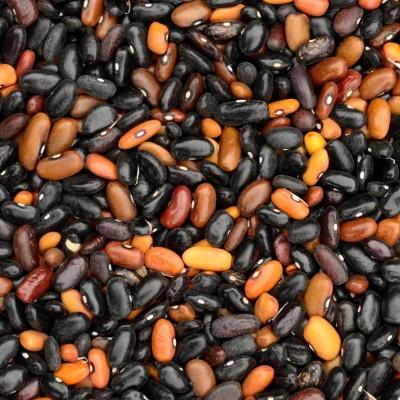Beefy Resilient Grex
Crop: Bean (Phaseolus vulgaris)
Use/Type: Dry
Breeder: Carol Deppe Fertile Valley Seeds
OSSI Pledge Date: January 2015
Release Date: Before 2015
Bred for Organic Systems: Yes
Commercial Availability: Yes
Variety Type: Finished Variety
Description
“Bred for organic systems. The most intensely beefy flavored bean I have ever eaten. Also the most productive dry bean I have ever grown by a factor of 2X or more. This is a segregating population of beans that represent the F3 and F4 of crosses between ‘Gaucho’ common bean X ‘Black Mitla’ tepary bean.) (Phaseolus vulgaris X Phaseolus acutifolius). ‘Gaucho’ is a very early, very delicious gold dry bean. ‘Black Mitla’ tepary is a widely adapted bean with a powerful delicious flavor as a dry bean. Both are small beans round in cross section and about twice as long as wide. Both are easy to thresh. Teparies are unusually heat resistant and drought hardy, and are resistant or tolerant to diseases common beans succumb to. Common bean varieties tend to yield more. In 2009 I was trying to do seed increases on the pure varieties, which shouldn’t have crossed since they are different species. Such crosses are “against the rules.” The beans were unruly. I got about 5% crosses from patches that were 12′ apart, as evidenced by about 5% black beans in the 2010 grow-out of what I thought was (and what looked like) pure (gold-seeded) ‘Gaucho’. I couldn’t think of any cross that has more potential for producing interesting and highly resilient dry bean varieties than this cross, though, however unintended. So I hand-sorted out several thousand black seeds representing those crosses and planted them in 2011 to produce Resilient Bean Breeder F3. These turned out to be the most productive dry beans I have ever seen. When I cooked up a pot of the mixed colors, the flavor blew me away. It tastes more beefy than beef does. The plants are mostly short-vined in type, and hold their pods up off the ground so can be handled like a bush type. (Bushes are also segregating.) To harvest I clip or pull plants and roll up the tangled row-shaped mat of beans. About ¾ of the beans are black; the rest are brown, tan, gold, or speckled. Maturity is a little later than ‘Gaucho’ but still quite early. (Presumably there will be continuing segregation for plant type, maturity, drought resistance, disease resistance, and bean color and flavor.) I am selecting gently for earliness (by eliminating any plants that are not dry along with the main crop) but not selecting otherwise. Save seed from the plants that do best for you and breed your own unique varieties adapted to your own needs and conditions. Or just use as a mix, as I am. This should be particularly good material from which to select varieties for short-seasons, cool or cold or hot summer weather, drought hardiness, yield, and disease resistance. (Note: This is essentially the same material I sold last year as ‘Resilient Bean Breeder F3’. It has now earned a name and permanent place in my garden.) To cook Beefy Resilients I soak for 24 hours with adequate stirs and occasional water changes; soaking time is variable, but they all swell completely in that time. Cooking time is uniform, about 45 minutes.”
Availability from OSSI Seed Company Partners

